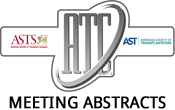2019 American Transplant Congress
Withaferin A Shifts Circulating Lymphocytes toward Protective T Cell Subsets and Prolongs Islet Allograft Survival in a Mouse Transplant Model
*Purpose: : Immunosuppression protocols improve the efficacy of allogeneic islet transplantation. However, decline in islet graft function and toxicities imposed by current immunosuppressant drugs remain…2019 American Transplant Congress
Torque Teno Virus is a Prognostic Biomarker for Acute Biopsy-Proven Alloreactivity in Kidney Transplants
*Purpose: Drug-induced immunosuppression in kidney transplantation is crucial to prevent allograft rejection, but increases risk for infectious, cardiovascular and malignant disease. Tailoring of immunosuppressive drug…2019 American Transplant Congress
Blockade of C3aR1 Signaling Suppresses Alloreactive CD8+ T Cell Immunity and Prolongs Murine Cardiac Allograft Survival
Icahn School of Medicine at Mount Sinai, NY, NY
*Purpose: Activation, differentiation and expansion of alloreactive CD8+ T cells, the dominant effectors that mediate murine heart allograft rejection, requires allorecognition, costimulation, and cytokine-initiated signals.…2019 American Transplant Congress
Donor-Recipient HLA Mismatched Peptides Calculated by PIRCHE Algorithm Associate with De Novo Donor-Specific Cellular and Humoral Alloreactivity and Predicts Inferior Graft Outcome
*Purpose: PIRCHE-II algorithm predicts mismatched donor-derived HLA peptides number presented on recipient HLAclass-II molecules to recipient T-cells (indirect pathway of allorecognition) and has been associated…2019 American Transplant Congress
Role of Innate Allorecognition Pathways in Mouse Renal Allograft Rejection
*Purpose: Allograft rejection is initiated by host immune system distinguishing between self and allogeneic non-self (allorecognition). Paired immunoglobulin-like receptor (PIR) and CD47 are molecules expressed…2019 American Transplant Congress
Transplantation Alone Induces Myeloid-Derived Suppressor Cells Which Can Suppress T Cell Responses
University of Maryland, Baltimore, MD
*Purpose: Myeloid-derived suppressor cells (MDSC) are a naturally occurring, heterogeneous population of highly immunosuppressive CD11b+GR-1+ cells that expand in response to inflammatory conditions. MDSCs develop…2018 American Transplant Congress
Autophagy Impacts Specificity and Characteristics of Innate Alloimmune Responses in Aging
Transplant Surgery Research Lab, Brigham and Women's Hospital, Boston, MA.
Aging and chronic antigen exposure shape the balance of innate and adaptive immunity. We hypothesized that autophagy will impact the homeostasis of innate and adaptive…2018 American Transplant Congress
Allogeneic T Follicular and T Conventional Responses Assessed by Proliferation, Cytokine Production, and TCR Clonality
1Thomas E. Starzl Transplantation Institute, Pittsburgh; 2Adaptive Biotechnologies, Seattle.
Background: Human CD4+ T cell allo-immunity plays pivotal roles during cellular and humoral allograft rejection. Our previous analysis showed that allo-reactive precursors were present in…2018 American Transplant Congress
Genome Wide Non-HLA Alloimmunity Contributes to Graft Loss after Kidney Transplantation
BackgroundChronic rejection is the main cause of renal transplant loss after the first year and has mostly been attributed to alloimmune responses against human leukocyte…2018 American Transplant Congress
Specific Monocyte Memory to Allogeneic MHC Mediated by Paired Immunoglobulin Receptors (PIR)
Monocytes distinguish between self and allogeneic non-self and contribute to allograft rejection by generating mature, IL-12+, DCs. The initial trigger of monocyte differentiation to DCs…
- « Previous Page
- 1
- …
- 5
- 6
- 7
- 8
- 9
- …
- 16
- Next Page »
